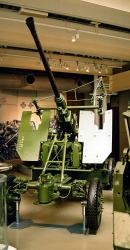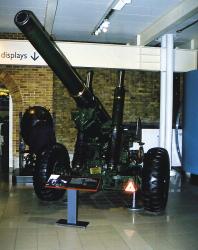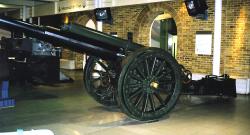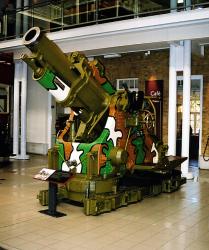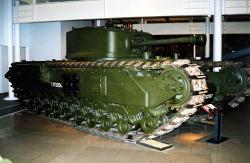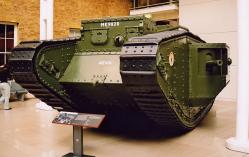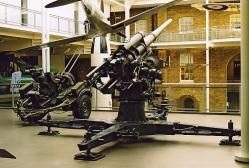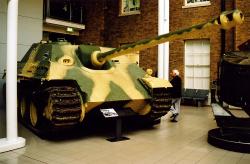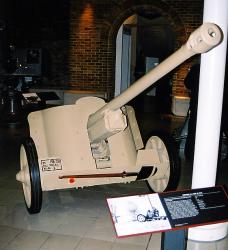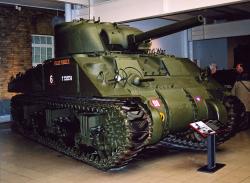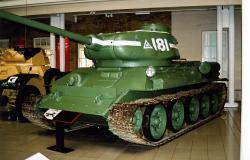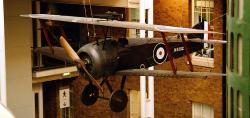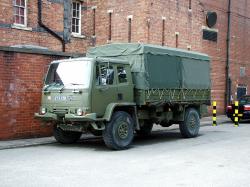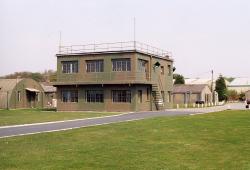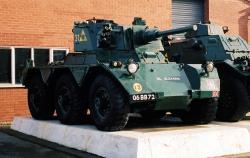Translate this Page
Recent images :
- International Harvester M5 halftrack
- Dassault Mystère Mk IVa number 146
- Ark Royal, Anti-ship missile defence gun.
- RAF Series 2 Land Rover
- Lightweight, air portable Land Rover
- Daimler Ferret Mk 1/2 Armoured Car
- RAF Mountain Rescue Series 3 Land Rover
- French Bronze 6 pounder cannon
- Farsley South African War Memorial
- Farsley War memorial
The Imperial War Museum
Photographs taken by kind permission of the IWM in London. For more details see Military Museums
Click on the entry for a larger image and details, or click to go back to the previous index
The 40mm L/60 automatic anti-aircraft gun was designed in Sweden by Bofors in 1928. It became so successful it was simply known as a 'Bofors gun' and in various guises has been used by many armed forces up to the present. This particular example date...
Imperial War Museum, London, England. October 2003.
This British field gun was introduced in 1904 and was primarily used during World War 1. It could fire an 8.4kg shell up to 5965 metres and had a calibre of 84mm.
Imperial War Museum, London, England. October 2003.
The 25lbr Mk II QF gun was the standard British divisional field gun from the 1940's up to the late 1960's. It could be used in both the close support and anti-tank roles. The large wheel-like disk mounted horizontally under the body of the carriage ...
Imperial War Museum, London, England. October 2003.
A medium cailbre artillery piece brought into service in 1941 (this one dates from 1942) was still being used in the 1970's. It could fire a 45.4 kg shell up to a range of 14,810 metres or more than 9.2 miles.
Imperial War Museum, London, England. October 2003.
Medium artillery piece brought into service in 1904 and used extensively during World War 1 both on the Western front and in the Middle East. It's use declined during the Second World War. It had a 127mm calibre, 27.2 kg shell and a range of 12,700 m...
Imperial War Museum, London, England. October 2003.
A heavy seige howitzer from the First World War. This piece came into service in 1914 and it's incredible 290lb (131.5kg) shells would pound indirect targets up to 5.7 miles (9200metres) away. This kind of heavy artillery barrage became iconic of bat...
Imperial War Museum, London, England. October 2003.
The Churchill was designed before the war and early, unreliable versions were rushed into service, proving disastrous. Between 1942 and 46 however they were improved and were used as heavy infantry support tanks in North Africa and Italy, then later ...
Imperial War Museum, London, England. October 2003.
This particular example was produced in 1918 and belonged to B Company, 4th Battalion Royal Tank Corps. It was armed with a 6lb'er gun on either side and four .303 inch Hotchkiss machine guns. It is similar to the type used in the battle of Cambrai, ...
Imperial War Museum, London, England. October 2003.
This important field gun was introduced in 1897 and was the standard French fieldpiece into the 1930's. It played an important role in the German defeat at Verdun in 1916 and could fire a 7.2kg shell a maximum of 6850 metres.
Imperial War Museum, London, England. October 2003.
The premier, multi-purpose gun of the second world war, the German 88 was respected and feared wherever it was encountered. A high muzzle velocity, good accuracy and penetrating ammunition, as well as plentiful production meant that this AA gun could...
Imperial War Museum, London, England. October 2003.
This tank destroyer from 1943 was based on a Pzkpfw 5 Panther chassis and mounted a powerful 88mm anti-tank gun, the equal of almost all allied armour during the war. This particular example was knocked out in Belgium in 1944.
Imperial War Museum, London, England. October 2003.
Used on all fronts throughout the second world war the 5cm pak38 was the mainstay of the German infantry's anti-tank artillery. Designed in 1940 it fired a 2.2kg armour-piercing shell up to 2,650m range.
Imperial War Museum, London, England. October 2003.
This British version of an American tank was used in the North African desert campaigns of 1941 and fought at El Alamein. It was originally armed with a 75mm gun in the hull, and a 37mm gun in the turret which gave it a fighting chance against the Ge...
Imperial War Museum, London, England. October 2003.
Between 1942 and 1946, 40,000 of these important tanks were built, pouring much-needed Allied armour into the push against the previously indestructable German Panzers. This one is in the colours of the British Guards Armoured Division and was armed ...
Imperial War Museum, London, England. October 2003.
Widely thought the be the best tank of the war, the T34 was designed in 1939 but first appeared in battle in June 1941. By the end of the war 40,000 had been produced and it continued to serve in various armed forces from 1943 right up to 1985. This ...
Imperial War Museum, London, England. October 2003.
The Sopwith Camel (so called because of the hump in the forward fuselage between the pilot and the propeller) arrived late in the First World War, entering service on the western front on 4th July 1917, to late to prevent the 'happy time' in April th...
Imperial War Museum, London, England. October 2003.

